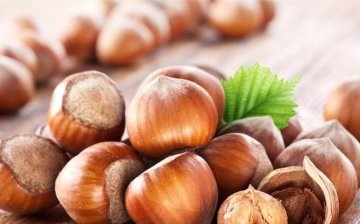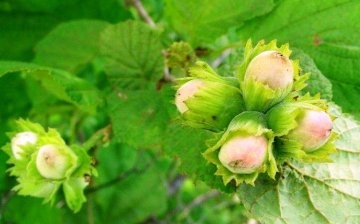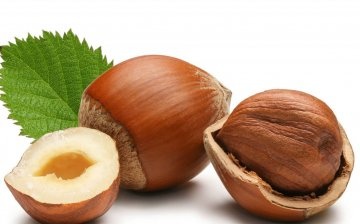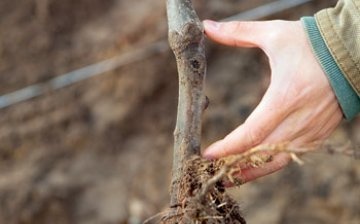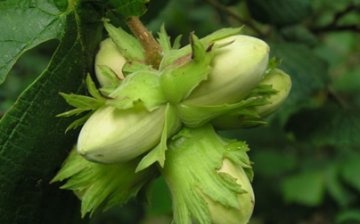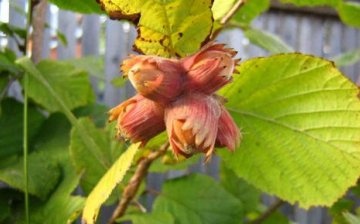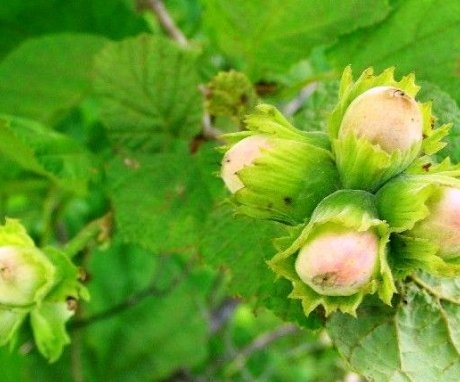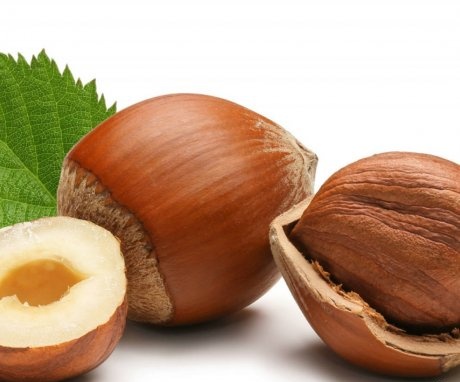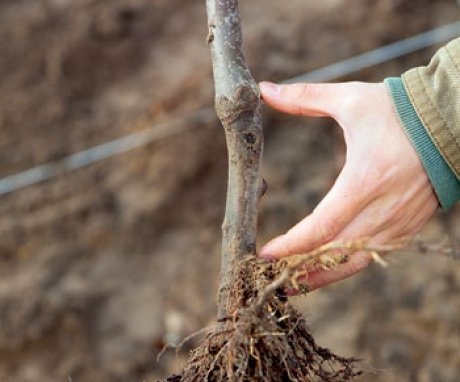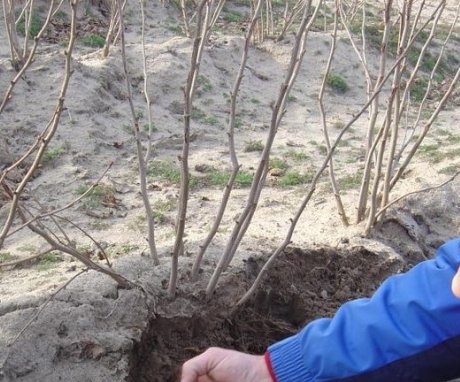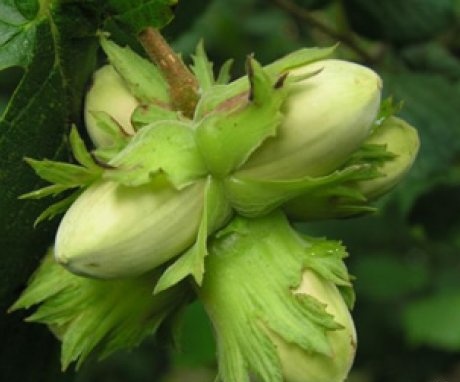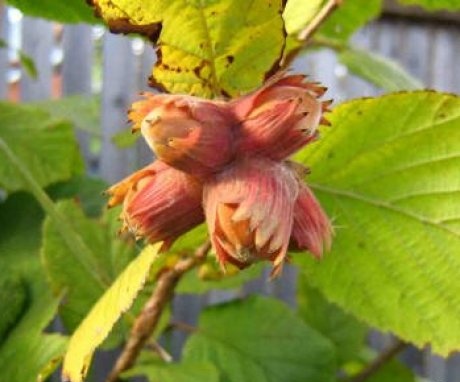Growing a hazelnut tree: reproduction, planting and care of seedlings
In our country, the fruits of hazel have been eaten for a long time. They went to the forest for nuts, collected, harvested and replanted walnut trees and bushes closer to the house. Domesticated hazel began to be called hazelnuts... The first mentions of hazelnut (hazel) are found in the records of the ancient Romans and Greeks. It is believed that they were the first to domesticate this wonderful plant. Scientists believe that hazel was the main plant, the fruits of which ten thousand years ago, at the end of the ice age, saved our ancestors from hunger.
Content:
- Features of the structure of the tree
- Popular varieties
- Breeding methods for hazelnuts
- Landing: choice of location, timing
- Seedling care
- Diseases and pests of the tree
Features of the structure of the tree
Hazelnut belongs to the birch family, the genus hazel. The plant looks like a tree-bush with many trunks ranging in height from three to six meters, the crown in adult trees can reach 8 meters in diameter. Hazelnut is a monoecious wind-pollinated plant: male and female flowers form on the same tree. Male flowers are formed by the end of summer, inflorescences in the form of long earrings.
By the beginning of flowering, the gray-brown inflorescences elongate, become friable and change color to yellowish-green and golden during flowering. The female flowers are similar to ordinary buds; during the flowering period, they emit a thin column with red stigmas.
The hazelnut tree has a powerful branched root system.
Hazelnuts - nuts - are very tasty, nutritious and healthy. They contain all amino acids, mineral salts, vitamins A, B, C, D, E. Nuts are very high in calories due to the large amount of fats they contain (65-70%). They are easily absorbed by the human body.
Popular varieties
In the fifties of the last century, Academician Yablokov began breeding work to develop frost-resistant varieties of southern hazelnuts, crossing it with wild hazel.
Thanks to the work carried out, varieties were bred that are resistant to frost and retain all the wonderful taste qualities of hazelnuts:
- Academician Yablokov - reddish leaves. Fruits (in a bunch of up to 12 pieces) are quite large (2.6 x 1.6 cm), weight about 3.5 grams. The shell is thin. Yield - up to five kilograms of fruit from a bush. Male flowers often do not tolerate frost, therefore, to pollinate female flowers next to a plant of this variety, it is recommended to plant Pervenets or Early Tambov.
- Tambov early - green leaves. The nuts are not very large - 2.1 x 1.4 cm, weight up to 2 grams. The shell is thin. Nuts of this variety have a high oil content. The variety is high-yielding and frost-resistant. Well suited for pollination of any varieties of hazelnuts.
- Moscow ruby - red leaves, large nuts - 2.8 x 1.8 cm, weight up to 4 grams, up to 10 nuts in a bunch. A large number of male flowers are formed, they are frost-resistant. Productivity - up to three kilograms of fruits from a bush.
- Ekaterina - the leaves are red. Large nuts - 3 x 1.9 cm, weight up to 5 grams, up to 8 nuts in a bunch. The shell is thin. Fruit ripeness occurs in September. Hazelnut This variety is pollinated in the same way as the variety Akademik Yablokov.
- The firstborn is green leaves. Fruits are large 2.7 x 2.1 cm, weight up to 3 grams. The shell is not very thin. The variety is considered frost-resistant with good yields. Fruiting in early September.
- Ivanteevsky red - leaves are red, dark green by autumn. Nuts are medium, weight up to 2 grams. The variety is frost-resistant with high yields. The most suitable pollinator for green-leaved varieties.
- Pushkin's red - burgundy leaves, dark green by autumn. Nuts are large, 2.3 x 1.7 cm, weight up to 2.3 grams, up to 10 fruits in a bunch. Recommended as a pollinator for green-leaved varieties.
- Sugar - leaves of a dark cherry hue. Nuts are small, 1.7 x 1.8 cm, weight up to 2 grams. Very thin shell. The variety is high-yielding, frost-resistant. The fruits ripen in early September. The male flowers are abundant and frost-resistant.
- Isaevsky - red leaves, large fruits. The variety is one of the most frost-resistant and high-yielding varieties.
- Masha is a red-leaved hybrid. The fruit is medium in size, the shell is thin. The variety is frost-resistant and high-yielding.
- Smolin - red leaves. Nuts are medium in size, oblong in shape, clusters contain 10-12 fruits. The shell is thin. The variety is high-yielding, frost-resistant.
To increase yields, you need to plant two or three varieties of hazelnuts, since many varieties need cross-pollination.
Breeding methods for hazelnuts
Hazelnuts can be propagated in three ways:
- Seed
- Vegetative
- Vaccination
The most convenient way for gardeners is vegetative. Way breeding hazelnuts seeds used mainly by breeders, since hazelnuts grown from seeds do not fully retain the properties of the variety. Specialists, using seed propagation, obtain new, improved varieties of hazelnuts.
Reproduction by grafting is a rather complicated method, and you can use it with some experience, since cuttings take root rather badly.
Seed method:
- Choose large, ripe nuts for planting. To protect against rodents, spray the nuts with kerosene just before planting.
- When planting seeds in the spring, three to four months before planting, place them in water for five days, then dry them and hold them for 3-4 months in the sand at temperatures from zero to five degrees for stratification.
- The seeds in the sand must be mixed every 2 weeks. At the end of stratification, the seeds are placed under snow.
- They are planted in the soil to a depth of 6 centimeters in rows according to the scheme 35 x 10 cm.
- When planting seeds in the fall, it is recommended to mulch the soil with moss or dry leaves.
Vegetative method. This method of propagation is the easiest and simplest and allows you to keep all the qualities of the variety. There are several options for vegetative reproduction:
- Dividing a bush is the easiest way to propagate a plant. Dig up the hazelnuts and divide them into parts with a pruner or a shovel so that each one has shoots of about 20 centimeters, a clod of earth should remain on the roots.
- Layers (bow) - near the nut, according to the number of layering, make grooves 40 centimeters long and 15 centimeters deep, set pegs at the end of the grooves. Place the shoots in the grooves and attach them with wooden hooks. Bring the shoots up and tie them to the pegs. The top at the height of the fifth or sixth kidney must be cut off. To enhance root growth at the points of the bend of the appendix, shallow transverse cuts in the bark can be made. Fill the grooves with soil with humus and mycorrhiza and water.
- Horizontal layering is a very laborious method, but from one shoot you get from three to five layering. In spring, select the shoots (which have the most good, dense buds) about one and a half meters high and a little less than a centimeter in diameter at the base. From the center of the bush, make grooves about 10 centimeters deep and the same width.Carefully, trying not to damage the buds, put the shoots there and attach them to the bottom with hooks, pinch the ends. It is not necessary to cover with earth. 40-50 days after the appearance of three to four leaves, the grooves are covered with soil with mycorrhiza, leaving a growth bud on the surface. During the summer, you need to regularly water the layers with water and sprinkle with earth five times. By autumn, bumps about ten centimeters high will form above the layers. A year later, by autumn, the shoots are dug up, cut off from the mother bush and divided into parts, each of which must have a shoot and roots.
- Vertical layering - in early spring, prune old branches to a height of 8 centimeters, for better bud opening and enhanced shoot growth at a height of 50 centimeters, cover the hemp tightly with foil. Three times the shoots need to be covered with a layer of humus. The first time - when the shoots grow to a height of 10-15 cm - add a layer of humus 5 cm. The second time - when growing up to 20-25 cm - add 12 cm humus. The third time - when the shoots grow up to 30 cm - add a layer of humus 20 cm During the summer, the soil around the bush should be watered and weeded. After the last hilling peel off the film in mid-July. When hilling the shoots, remove the lower leaves. In autumn, carefully remove the soil poured during hilling and separate part of the shoots with roots with a pruner or shovel.
- Root suckers - separate from the rhizome with an ax two-three-year-old root shoots located at the edges of the bush, after clearing them from the ground. It is necessary to plant in a permanent place 2-3 processes in one hole.
Landing: choice of location, timing
The soil for planting a nut should be well moistened (but not waterlogged) and fertile. In general, the plant grows on any soil, except for acidic ones. Such soils can be treated with lime at the rate of 0.5 kg of lime per 1 square meter of soil.
You can plant a nut both on the plains and on the slopes, avoiding the southern ones, since the buds can bloom early from the heat and die from the returned frosts.
Hazelnuts grow well on the eastern and northern slopes, in places where the difference between day and night temperatures is minimal. It is advisable to choose a sunny, windless place for the hazelnuts, at least five meters away from other trees with a voluminous crown.
Hazelnuts can be planted on uneven areas that are not suitable for planting other crops. The plant has a superficial root system, thanks to which it strengthens the slopes well and prevents soil erosion.
Optimal time for disembarkation to a permanent place seedlings - early October, when the soil is still moist and warm.
You can also plant in early spring, the main thing is that the soil has time to warm up. The soil for planting must be prepared six months in advance: for autumn planting - preparation in spring, and vice versa, for spring - in autumn. It is necessary to loosen the soil, if necessary add fertilizers containing potassium and phosphorus. Then plow the soil to a depth of about 40 centimeters for better breathability and moisture retention.
Hazelnuts will bear fruit well when applied to the soil with organic fertilizers: 2-3 kilograms of manure or compost per 1 square meter of land. The soil during this period (six months) is under fallow, resting, it must be regularly loosened and weeded weeds.
The optimal scheme for planting seedlings is 6 x 6 m or 5 x 5 m, with a shortage of space, you can plant 2 x 5 m, 3 x 5 m.It is important to remember that the more space a tree has, the better it grows and bears fruit.
Half a month before planting, prepare a hole half a meter deep and half a meter in diameter, fill it with a mixture:
- Soil (top layer)
- Humus - 2-3 buckets or manure - 5-8 kg
- Superphosphate - 150 grams
- Potassium salt - 50 grams
- Mycorrhiza - 2-3 handfuls to a depth of 15cm.
Place a peg in the center of the pit, near which you place seedling... Before planting, the roots of the hazelnuts need to be straightened and lowered into a chattering solution (a mixture of earth and water).Deepen the level of the root collar by 3 cm, but the collar itself must not be covered with earth. Trim the seedling after the fifth or sixth bud, leaving about 25 centimeters in height.
Regardless of the weather conditions, the seedlings must be watered at the rate of 4 buckets of water under each tree and the soil must be mulched with any suitable material (sawdust, needles, humus, etc.). Repeat watering after a week.
Seedling care
Care for hazelnuts is very simple: they say that this is a plant for the lazy. It is enough to regularly weed the ground without touching the root system, you can carry out mulching with cut grass. Worms develop well under it, which improve the quality of the soil and make it more fertile. Watering needed mainly in June-July. After watering or raining around the bush, loosen the soil no deeper than 15 centimeters so as not to hurt the roots.
To improve fruiting, it is recommended to introduce manure or compost into the soil twice a year (2 buckets per tree per tree), once a year - mineral fertilizers.
In summer it is recommended to carry out top dressing ash. Nitrogen fertilizers reduce the yield of hazelnuts, although they make the bush lush and beautiful, so it is better not to use them when feeding the nut.
To get good harvest it is important to do the formation of the bush correctly. In the first three years, the root system develops better, after this time, increased growth of shoots begins, from which the trunks are formed. From the second or third year, you need to carry out the procedure trimming bush. Choose the 5-8 strongest shoots, from which the crown of the bush will be formed, cut the rest at the root. In hazelnuts, only young shoots are left, poor harvests are removed.
You need to cut off the branches at the base of the bush.
At the 11th year of growth of the nut, before the leaves begin to bloom, rejuvenate the tree: cut off three old trunks and shorten the young ones. Hazelnuts can grow in one place for more than a hundred years. You do not need to cover the hazelnuts for the winter, they are quite frost-resistant.
Diseases and pests of the tree
Hazelnut resistant to diseases and pests, nevertheless, for prevention, you can process the branches with iron sulfate. This should be done in late October and early spring.
Pest and disease control of the tree:
- For hazelnuts, the great danger is the May beetle, whose larvae love to feast on the roots of the tree. If the larvae of the May beetle are found in an amount of more than two per 1 square meter, the pest must be destroyed before planting the plant.
- Nut weevil can destroy up to 50% of the crop hazelnuts... In the spring, before the beetles appear, add granulated 10% Bazudin to the soil at the rate of 2.5 grams per 1 sq. meter. After the appearance of the beetles, the trees are sprayed with Karbofos 0, 06 grams per 1 square meter. Collect and destroy prematurely fallen nuts. In the morning, shake off the beetles on the canvases spread on the ground.
- The hazel beetle loves to lay eggs under the bark of young shoots, the beetle larvae gnaw out the core of the shoots, as a result of which they dry out. All dried up branches are needed prune 15 cm below the dried place and then burn. In mid-May, spray the plants with 1% Karbofos.
To prevent infection of hazelnuts with diseases and pests, it is necessary to remove and burn the fallen leaves in the fall, and then dig up the ground under the bushes of the plant.
In this way, it is destroyed powdery mildew, it tolerates winter well on fallen leaves, and weevil larvae. In the summer, regularly collect and destroy the affected fruits. With proper care, hazelnuts are practically not susceptible to diseases and pests.
More information can be found in the video.



